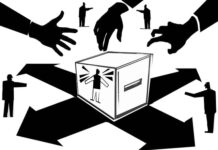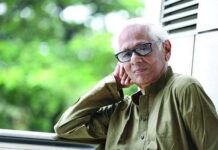
How long before Dhaka stops moving completely?
My relationship with this great city of ours is derived from a love of my history, which is so tightly intertwined with its own, and a hatred for the little-big things which make my residence here almost unbearable.
In this regard, I suspect, I am not much different.
While there are the nuances of class, wealth, and culture inextricably coiled around each of our individual experiences, since time, impatience, and frustration are inherently universal human traits, the problem of traffic is one problem which we all have in common.
The permanent problem
As far as progress and development are concerned, if we are to see the patterns of into-city migration (forced or otherwise), this is a problem that is here to say. The rich continue to purchase more cars, with individual vehicles for individual members of the family; the poor continue to be subjected to the chaotic (though cheap) experiences of public transport.
Those in the middle, they oscillate, dependent on situation and the obesity/anorexia of their wallets. Share a car, ride the bus, take a CNG: A product of luck and happenstance.
While I cannot help but appreciate the government’s efforts when it comes to at least trying to solve this problem by constructing flyovers and u-loops, and plans for MRTs and BRTs and other such acronyms the expansions of which I have gotten confused in the hazy smog of Dhaka’s choking air, these are temporary solutions, at best.
For one, the unorganised disarray in which the construction of these is carried out causes immeasurable damage, in terms of lost time, lost hours, in terms of creating dangerous situations right there on the road.
And, more importantly, by the time it is done, sure, a few are benefitted by the shortcut provided by the likes of the Uttara flyover or Mohakhali, underneath, most are suffocated in much the same way as they were before: All it does is move the bottleneck from one end of the road to another.
This is reflected in the fact that Dhaka’s average traffic speed, over the past few years, has crawled slowly to a dismal and unacceptable 6km/h by some estimates. In the long run, this cannot go on.
The temporary solution
In the past few months, ever since the rains have stopped (though they are back again), I have not hailed a CNG once. My schedule is jam-packed with long commutes and CNGs were an annoying necessity.
They were faster than cars, granted, but their fares were exorbitant, and the hassle of hailing one, and bargaining, and convincing one of them to go at your fare was a cause for anxiety that I could do without. And in this regard, too, I suspect, I am not alone.
Ride-sharing can, to a great extent, if utilised to maximum capacity, reduce the pressure on our limited roadspace
And then Pathao and Uber came to the rescue. Thanks to their persistent expansion, and a series of rather tempting promotional discounts, I had reduced my one-and-a-half hour commute to 45 minutes (thanks to Pathao and Uber Moto’s bikes) or was comfortably seated in an air-conditioned Premio or Allion (thanks to the promos).
To many like me, ride-sharing apps (there are others) are a godsend. They have given us the opportunity to deal with Dhaka’s ugliest feature. And this is reflected in people’s responses to the CNG strike. “They deserve it,” they said, because of how ruthlessly they charged, treating the city as their personal playground.
But, while I too have suffered at the verbal irreverence of a callous CNG driver, it is important to understand that these individuals are not exactly living the high life. They are, at the end of the day, “employees” in a sense, because they have to provide a certain amount to their owners, who oftentimes demand more than legally allowed.
The CNG drivers are powerless, for the causal chain bleeds on to the consumer, who are met with a driver who can’t be bothered to deal with your bargaining chips for he has to give back over Tk1,000 to the owner. But you have to get to your destination without splitting your wallet in two. And within this hatred between consumer and employee, the fat cats make their money.
It is important for us to be empathetic to the plight of the CNG driver, as much as we may hate it. By recent reports, their revenue has gone down by a third, and these are not well off individuals.
And ride-sharing apps, as much as we like them, for now, aren’t that affordable for individuals. Whereas Pathao is good for the individual in a hurry, it still is not that far off from the CNG fare, and does not cater to those who can’t even afford that. Uber remains too expensive for the individual and must be shared, if it is to be affordable to the suffering middle class.
And, of late, there are reports of several people having suffered from accidents. These motorbikes, swift as they are, are still being ridden in a city whose traffic system is chaotic at best. And the riders themselves are to be blamed, taking risks pumped by the testosterone-fuelled daredevil which apparently resides in most riders in this city. I cannot count the times I have escaped death by a fraction of a second.
But what all these hint at, at least, is that the commuter is in desperate need of a revolution. We have more options, and ride-sharing can, to a great extent, if utilised to maximum capacity, reduce the pressure on our limited roadspace.
But Dhaka itself needs a make-over.
How long will motorbikes have the room to go in between vehicles before those spaces are filled up?
How long before there’s a serious accident and someone dies and ride-sharing apps are banned? How long before Dhaka stops moving completely?
SN Rasul is an Editorial Assistant at the Dhaka Tribune. Follow him on twitter @snrasul.
Source: Dhaka Tribune.









